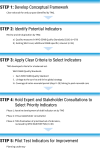Global prioritised indicators for measuring WHO's quality-of-care standards for small and/or sick newborns in health facilities: development, global consultation and expert consensus
- PMID: 41120171
- PMCID: PMC12542562
- DOI: 10.1136/bmjopen-2025-100338
Global prioritised indicators for measuring WHO's quality-of-care standards for small and/or sick newborns in health facilities: development, global consultation and expert consensus
Abstract
Objectives: The aim of this study was to prioritise a set of indicators to measure World Health Organization (WHO) quality-of-care standards for small and/or sick newborns (SSNB) in health facilities. The hypothesis is that monitoring prioritised indicators can support accountability mechanisms, assess and drive progress, and compare performance in quality-of-care (QoC) at subnational levels.
Design: Prospective, iterative, deductive, stepwise process to prioritise a list of QoC indicators organised around the WHO Standards for improving the QoC for small and sick newborns in health facilities. A technical working group (TWG) used an iterative four-step deductive process: (1) articulation of conceptual framework and method for indicator development; (2) comprehensive review of existing global SSNB-relevant indicators; (3) development of indicator selection criteria; and (4) selection of indicators through consultations with a wide range of stakeholders at country, regional and global levels.
Setting: The indicators are prioritised for inpatient newborn care (typically called level 2 and 3 care) in high mortality/morbidity settings, where most preventable poor neonatal outcomes occur.
Participants: The TWG included 24 technical experts and leaders in SSNB QoC programming selected by WHO. Global perspectives were synthesised from an online survey of 172 respondents who represented different countries and levels of the health system, and a wide range of perspectives, including ministries of health, research institutions, technical and implementing partners, health workers and independent experts.
Results: The 30 prioritised SSNB QoC indicators include 27 with metadata and 3 requiring further development; together, they cover all eight standard domains of the WHO quality framework. Among the established indicators, 10 were adopted from existing indicators and 17 adapted. The list contains a balance of indicators measuring inputs (n=6), processes (n=12) and outcome/impact (n=9).
Conclusions: The prioritised SSNB QoC indicators can be used at health facility, subnational and national levels, depending on the maturity of a country's health information system. Their use in implementation, research and evaluation across diverse contexts has the potential to help drive action to improve quality of SSNB care. WHO and others could use this list for further prioritisation of a core set.
Keywords: Health Services; NEONATOLOGY; Patient Reported Outcome Measures; Quality in health care.
© Author(s) (or their employer(s)) 2025. Re-use permitted under CC BY. Published by BMJ Group.
Conflict of interest statement
Competing interests: None declared.
Figures






References
-
- World Health Organization, UNICEF Survive and Thrive Transforming care for every small and sick newborn2019. [7-Aug-2025]. https://apps.who.int/iris/bitstream/handle/10665/326495/9789241515887-en... Available. Accessed.
-
- Lawn JE, Ohuma EO, Bradley E, et al. Small babies, big risks: global estimates of prevalence and mortality for vulnerable newborns to accelerate change and improve counting. The Lancet. 2023;401:1707–19. doi: 10.1016/S0140-6736(23)00522-6. - DOI
-
- World Health Organization, UNICEF Every Newborn: an action plan to end preventable deaths2014. [7-Aug-2025]. https://apps.who.int/iris/handle/10665/127938 Available. Accessed.
-
- World Health Organization Global Strategy for Women’s, Children’s and Adolescents’ Health, 2016-2030.2015. [7-Aug-2025]. https://www.who.int/publications/i/item/A71-19 Available. Accessed.
-
- United Nations Sustainable Development Goals. [7-Aug-2025]. http://www.un.org/sustainabledevelopment/health/ Available. Accessed.
MeSH terms
Grants and funding
LinkOut - more resources
Full Text Sources
Medical
